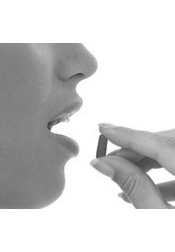Jamp-Cloxacillin capsules
This product is manufactured by Jamp Pharma Corporation using the ingredient cloxacillin.
This product is taken orally.

play
orally
Why is it prescribed?
Cloxacillin is used to treat mild to moderately severe infections caused by susceptible types of bacteria. This material will be limited to the treatment of infections of the respiratory tract (e.g. sinusitis, tonsillitis).
Use exactly as prescribed.
The absorption of cloxacillin is decreased by food. It should be taken on an empty stomach (1 hour before or 2 hours after a meal).
Take at even intervals around the clock as prescribed (e.g. every 6 hours translates to 4 times a day) until finished. Failure to take the complete course can result in incomplete elimination of the bacteria which can lead to a relapse of the infection. The prescribed course generally lasts a few days longer than symptoms of the infection (e.g. fever). Treatment usually lasts 14 days. If you miss a dose, take it as soon as possible. If it is almost time for your next dose, do not take 2 doses at once (unless you have been instructed to do so). Contact your pharmacist if you are not sure what to do.
Cloxacillin may produce an allergic reaction which can range in severity from a mild rash or itching to a life-threatening reaction. Contact your doctor or pharmacist if you experience rash, itching, fever, difficulty breathing, chest tightness or anything else that alarms you.
If diarrhea occurs (severe or persistent), contact your doctor or pharmacist. Do not treat diarrhea without being instructed to do so.
Alternatives
Other products that have the same ingredient as Jamp-Cloxacillin capsules are •Teva-Cloxacillin capsules •Teva-Cloxacillin solution •
See other products used in the treatment of •respiratory tract infections •sinusitis •tonsilitis •
The usual dose for adults is 250 mg to 500 mg every 6 hours depending on the severity of the infection being treated. The usual dose for children is 50 mg to 100 mg for each kilogram of body weight per day in equally divided doses every 6 hours.
Cloxacillin is an antibiotic medication that kills various bacteria. It works by inhibiting the synthesis of one of the building blocks needed for the bacteria to make its cell wall. This results in a cell wall that is defective and more likely to rupture. The effectiveness of cloxacillin depends on factors such as dose, concentration in the blood as well as other body fluids and tissue, and susceptibility of the organism. Cloxacillin will only kill certain types of bacteria sensitive to its antibiotic action. Infections caused by bacteria that are not sensitive to cloxacillin will not show improvement after taking this medication.
Along with its needed effects, cloxacillin may cause some unwanted or undesirable effects. Generally, cloxacillin is well tolerated and many people will not experience unwanted effects. The frequency and severity of these effects is dependant on many factors including dose, duration of therapy and individual susceptibility. Possible unwanted effects include:
- diarrhea
- loose stools
- heart burn
- nausea
- vomiting
- gas
Uncommon:
- allergy (e.g. hives, itching, rash, difficulty breathing)
- inflammation of the tongue and mouth
Rare:
- pseudomembranous colitis (inflammation of the colon caused by the overgrowth and toxin production of certain bacteria, causing diarrhea)
- blood in stools
- black hairy tongue
Allergic reactions can occur with cloxacillin use. People with a history of allergy, asthma, hay fever or hives seem to be more susceptible to these reactions. The reaction can be immediate and severe. Allergic symptoms include wheezing, hives, itching, swelling, spasms in the throat and breathing tubes, joint and muscle pain, difficulty breathing, fever and skin rashes. Nausea and vomiting are not symptoms of an allergic reaction.
Cloxacillin is a semisynthetic penicillin. If you have an allergy to penicillin, you should not take cloxacillin. Cephalosporins (e.g. cephalexin) are a distinct group of antibiotics related to penicillins. People allergic to cephalosporins may also be allergic to penicillins.
Taking the antibiotic repeatedly or for prolonged periods may result in bacterial or fungal overgrowth which can lead to a second infection. When this occurs, the cloxacillin may need to be stopped and another antibiotic prescribed to treat the new infection.
Diarrhea often develops while taking cloxacillin. This is sometimes caused by an overgrowth of bacteria in the gut that are not killed by the antibiotic. In severe cases, this may be life threatening and would require treatment with other antibiotics. In mild cases, symptoms disappear shortly after the drug is discontinued.
Drug Interactions: It is important to tell your doctor and pharmacist of any prescription or over-the-counter medications you are taking. In some cases, the dose of one or both drugs may need to be altered or another drug may be prescribed. The following drugs or drug classes have been known to interact with cloxacillin:
- warfarin (e.g. Coumadin®)
- probenecid (e.g. Benemid®)
- methotrexate
Use is not recommended in the following situations:
- allergy to any penicillin (e.g. amoxicillin)
Caution is recommended in the following situations:
- allergy to cephalosporins (e.g. cephalexin)
Use in pregnancy: Cloxacillin has been used in pregnant women without evidence of risk to the unborn baby. However, it should not be used during pregnancy unless clearly needed. Consult your doctor or pharmacist if you suspect you are pregnant.
Use while breastfeeding: Cloxacillin does appear in breast-milk but only in small amounts. Cloxacillin is considered compatible with breastfeeding. Consult your doctor or pharmacist before use.
